The Leica M Noctilux which costs $11,000 is a full frame F0.95 photographic lens. The SLR Magic HyperPrime CINE T0.95 is a full frame F0.92 lens designed for cinematographers with Leica M mount which retails for $3,000 – a third of the Noctilux.
It is quite a different lens to the Voigltander Nokton 25mm F0.95 for Micro Four Thirds. It covers a full frame sensor and APS-C mirrorless cameras like the Sony FS100 and NEX 7 whilst the Nokton vignettes on anything larger than Micro Four Thirds. I shot the above film on the Panasonic GH2 with Iscorama 36 anamorphic attached to the SLR Magic CINE but I am also using it on my NEX 7 and Fuji X Pro 1.
For me part of the reason I like such a fast aperture on a crop sensor is for a greater shallow depth of field and a creamier bokeh. But it goes without saying that this is the brightest lens I have ever used for low light. It is slightly brighter than the Vogitlander Nokton 25mm F0.95 at F0.92, and my testing confirms this. Since it also has a longer focal length of 50mm, the focus plane can be razor thin as you can see here, the end of the shelf disappears into the background despite being only 5cm from the back of the camera, and whilst the front of the lens is in focus the X Pro 1 body itself is isolated in the background! This has interesting implications for shooting close-ups wide open like Gail Tattersall did to great effect on HOUSE (see the EOSHD interview here).
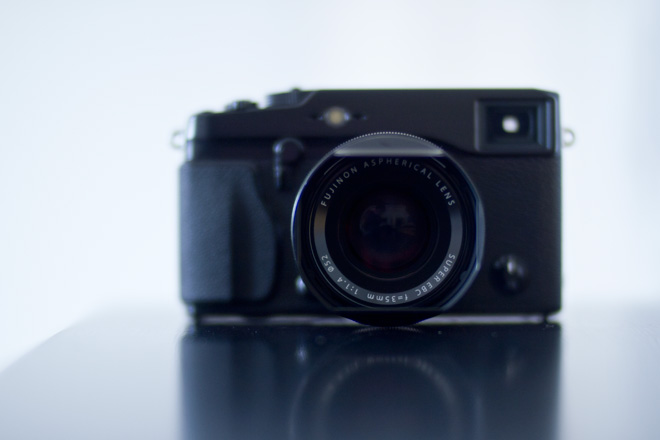
Cinema lenses justify their higher prices over photographic equivalents by having superior optical and mechanical properties.
For example the Zeiss CP.2 50mm T2.1 costs $3,900 and adheres to the cinema standard 82mm front filter, standard focus mechanics, comes in matched set of other focal lengths and has the cinema standard PL mount. Often a cinema lens is stopped down to between F5.6 and F8 for the focus puller, and for peak optical performance. A cinema lens must not change the field of view whilst racking focus (breathing, like the Samyang lenses do) and must be of high optical standard with perfect sharpness even wide open.
T stop is used instead of F stop in cinematography for shot matching, so that exposure does not change when swapping out primes for a different field of view. For example cutting into a medium-close-up at T5.6 with a 50mm as opposed to 21mm or 35mm, exposure must be identical to avoid unexpected subtle differences in brightness when the two shots are edited together with a jump cut. Photographic lenses measured in F stop vary slightly from one-another in terms of true light transmission (T stop) at every given F stop.
SLR Magic are a small company coming into the cinema market for the first time, so the lens does not come in a matched set of 5 other lenses of different focal lengths or feature a PL mount, but it does share many of the performance benefits of a cinema lens.
- It has premium optics with very little distortion or vignetting
- It does not breathe when racking focus
- The focussing mechanics are buttery smooth and designed to suit a follow focus
- The aperture ring is continuously variable (de-clicked) and can be adjusted silently and smoothly
- The aperture is rated in T-stop for shot matching – F-stops vary in true brightness between lenses
- At T0.95 the SLR Magic CINE is one of the fastest lenses designed for cinematography ever made
Only the Stanley Kubrick NASA built lenses for Barry Lyndon were faster than T0.95. So you can happily shoot scenes when natural light or even candles are preferable for atmosphere.
This is great news for cinematographers who just want the best image quality and focussing mechanics they can get their hands on and the Leica M mount means this lens is compatible with the FS100, AF100, GH2 and NEX 7.
Of course photographers will be glad to hear that they can use it as a Noctilux replacement on their Leica M8! The guys at DPReview also have the lens and are looking at it from a stills perspective, so stay tuned. There’s also now a Leica M adapter for the Fuji X Pro 1.
The lens is designed for professional cinematographers so $3000 means it is not affordable for the masses but compare it to other cinema lenses and full frame lenses optics like the Leica Notilux of a similar specification and it is quite a bit cheaper.
Some cinematographers working with rental gear and on somebody else’s set where other cinema lenses are in use may miss the standardised focus travel and 82mm filter thread and some photographers may deem the lens rather large and heavy. But these are minor points that most buyers of this lens won’t even take into account.
For consumers the photographic Voigtlander Nokton 50mm F1.1 is a very good lens for a much lower price but it is not as fast, it breathes, doesn’t have a de-clicked aperture and isn’t mechanically designed for cinematography.
The shoot
The GH2 is the only true 1080p ‘DSLR’. I would never shoot landscape like I did in the video above with a 5D Mark II, III or NEX 7 with their pseudo 1080p which isn’t 1080p at all – more like 720p. In my opinion they shouldn’t be allowed to put 1080p badges on the box!
For many shots actual 720p is fine but not for landscape where almost every part of the frame is a fine detail.
The detail the GH2 resolves in 1080p is astounding!

For The Shires video I used my own updated hack settings (EOSHD Unified Patch) which does 90Mbit ALL-I compression. I did use Driftwood’s latest Orion patch but after it filled up my 16GB card in 2 minutes I figured it just wasn’t practical to shoot with. The difference in quality between my patch and Driftwood’s is so minimal, I’d rather have 90Mbit and fit 30 minutes of footage on the card.
The anamorphic gave me a wider field of view and 2.66:1 which suited the epic landscape far better than a 50mm on the GH2 which is equivalent to nearly 100mm on full frame so almost a telephoto. The other benefit of the anamorphic is that it increased the field of view without reducing the shallow DOF, but just make sure you have some NDs to hand because at T0.95 in broad daylight you will be shooting at 1/4000!

Even in emergencies I don’t recommend going over 1/1000 on the GH2 as exposure in live view becomes ineffective after that point and only works during the recording. So your composition is overexposed by a huge degree then you get a massive shift in exposure as the real shutter speed kicks in when you hit record.
I shot outdoors at between F4 and F11. Only in the caves did I let the SLR Magic CINE go wide open, and it is a sharp lens even at T0.95! With an anamorphic, obviously at that speed (which is unheard of for anamorphic) it softens a bit but it is still useable! Some anamorphic lenses like the LA7200 are soft at anything faster than F4 so it is a testament to the quality of the Iscorama 36 and how good a match the SLR Magic CINE is for it that it could be tack sharp at F2 and usable at T0.95.
I used the Zacuto EVF as a monitor mainly, and it displays 2.66:1 no problem with the 1.5x anamorphic option. This really helps, otherwise you are composing shot after shot from a distorted image. White balance, colour and exposure are also far more accurate on the Zacuto’s superior LCD compared to the rather dodgy one on the GH2.
The SLR Magic CINE has a very nice look to the bokeh – very creamy even on fussy backgrounds.
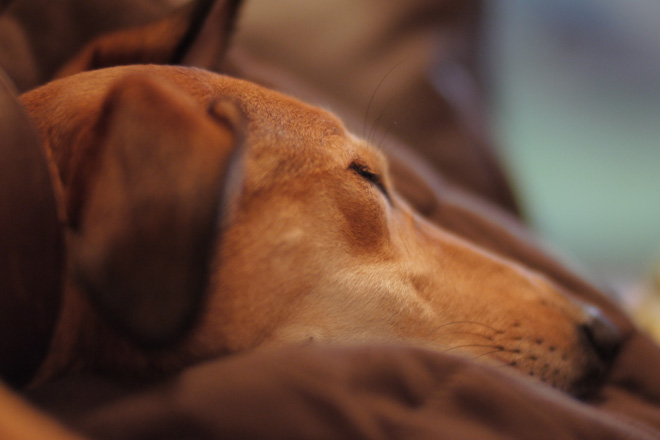
Here are some 1:1 crops of the SLR Magic CINE at T0.95 and stopped down (without anamorphic):
T0.95
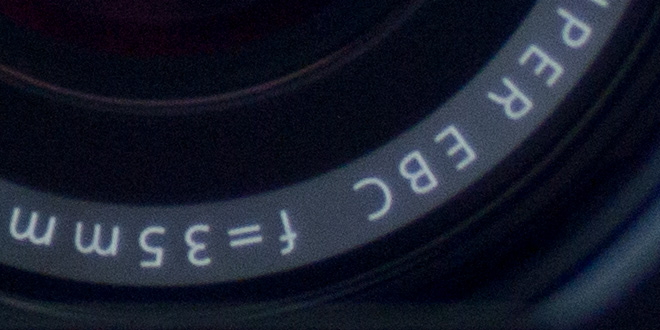
T2
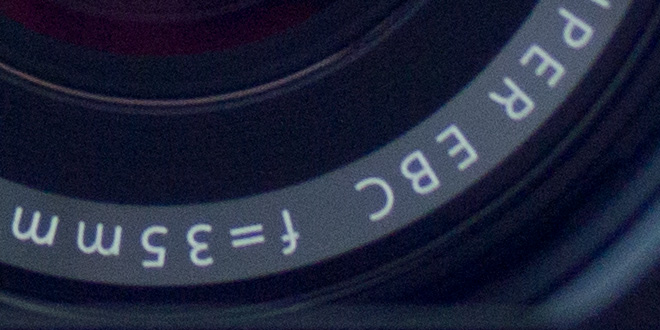
T4
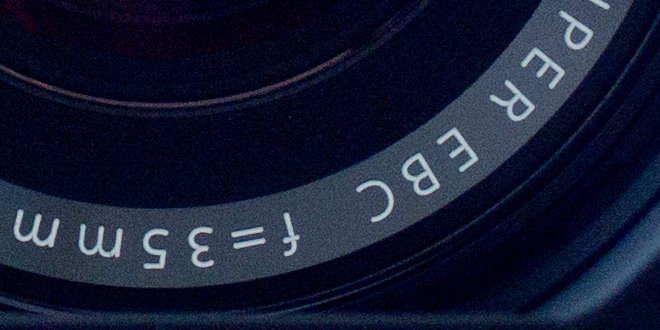
As you can see it sharpens up a lot at T4 but considering the size of the aperture, T0.95, optical performance is superb wide open. That subject above is a demanding one and viewed at 1:1, shot in 16MP RAW stills.
It is still early days for my shooting with the SLR Magic HyperPrime CINE but I will put a review online before long. I must say that for such a small company, new to the lens market to come along and be doing a lens with the performance and specification on display here is just astounding and a mega achievement. Well done!!
I’ve uploaded some 16MP stills from the GH2 taken at a range of apertures between T0.95 and T4 from which the above crops are taken. You can download the full 4752 x 3168 shots at Flickr here.
The SLR Magic HyperPrime CINE 50mm T0.95 and HyperPrime 12mm F1.6 are available to pre-order


